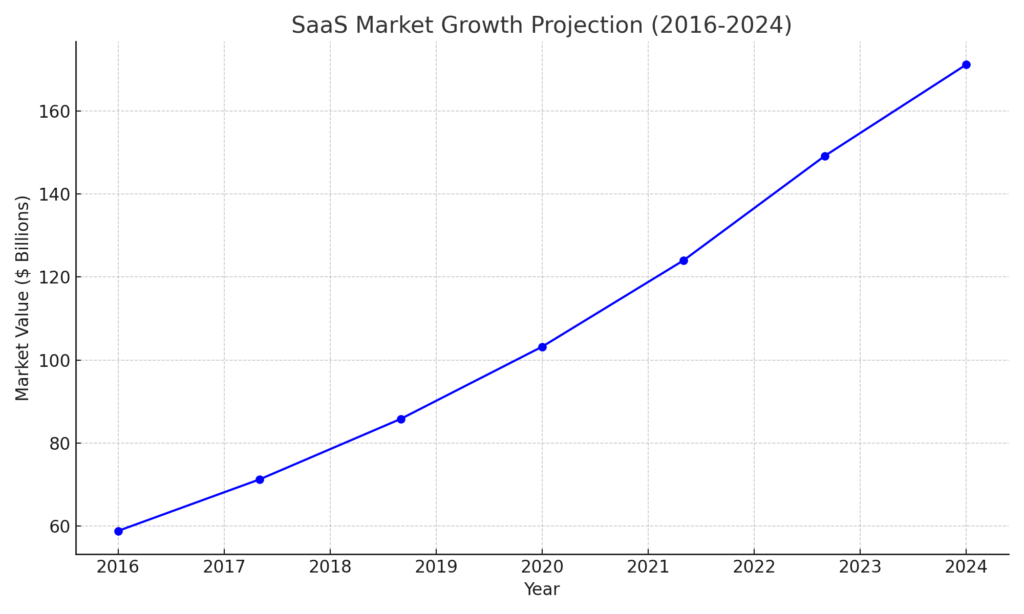SaaS Industry Growth: Witnessing an annual growth rate of over 20%, the SaaS market has seen revolutionary expansion over the last decade, reshaping business operations and software delivery. This article explores the drivers of this growth, including market stats, tech advancements, trends, and COVID-19’s impact, offering insights into the industry’s transformation and future.
Table of Contents
The Meteoric Rise in SaaS Market Value
The SaaS market has experienced exponential value growth in recent years. This section focuses on key statistics highlighting the market expansion, factors driving the SaaS market forward, and the impact of the COVID-19 pandemic on SaaS adoption.
Key Statistics Highlighting Market Expansion
The SaaS industry has witnessed significant growth, with staggering revenue generated by SaaS companies. According to industry analysis, the SaaS market is projected to reach a value of $171.2 billion by 2024, representing a CAGR of 21%, a remarkable increase from $58.8 billion in 2016.
The line chart below illustrates the rapid growth of the SaaS market value over the past decade:

Factors Driving the SaaS Market Forward
The SaaS Market growth can be attributed to several key factors. Firstly, the increasing adoption of public cloud services has paved the way for the widespread utilization of SaaS solutions. Cloud-based software delivery offers scalability, cost-effectiveness, and flexibility, making SaaS a preferred choice for businesses.
Secondly, the significant shift from traditional on-premises software deployment to SaaS solutions has fueled market expansion. With SaaS, businesses can eliminate the need for costly hardware investments and capitalize on the benefits of subscription-based models.
Lastly, the COVID-19 pandemic has acted as a catalyst for SaaS adoption, accelerating the market’s growth. As organizations rapidly transitioned to remote work, cloud-based solutions became essential for managing distributed teams and ensuring business continuity.
The Impact of the COVID-19 Pandemic on SaaS Adoption
The COVID-19 pandemic has transformed the SaaS landscape by spurring widespread adoption. As businesses faced the challenges of remote work and the need for digital transformation, SaaS solutions emerged as vital tools for collaboration, productivity, and operational efficiency.
Companies turned to SaaS to enable remote access to critical software applications, facilitate seamless communication, and empower virtual teamwork. The versatility, scalability, and accessibility of SaaS solutions proved instrumental in supporting businesses during these challenging times.
As a result, the pandemic has not only increased SaaS adoption but also accelerated the pace of innovation within the industry. Organizations have discovered the immense value of cloud-based solutions and are likely to continue embracing SaaS even beyond the pandemic.
Technological Advancements Fueling SaaS Industry Growth
Technological advancements have played a crucial role in fueling the growth of the SaaS industry. Innovations such as cloud computing, artificial intelligence, and data analytics have enhanced the scalability, performance, and customization of SaaS solutions. These advancements have allowed businesses to seamlessly integrate SaaS into their operations and leverage the benefits of cloud-based software delivery.

The emergence of cloud computing has revolutionized the SaaS landscape by providing scalable infrastructure and reducing upfront costs for businesses. Cloud-based delivery models enable seamless software updates and maintenance, eliminating the need for manual installations and allowing businesses to focus on their core competencies.
Artificial intelligence and data analytics have also played a significant role in driving SaaS industry growth. These technologies enable businesses to leverage vast amounts of data, providing valuable insights and enabling data-driven decision-making. AI-powered applications automate repetitive tasks, enhance productivity, and drive efficiency, enabling businesses to streamline their operations and achieve better results.
The customization and personalization capabilities offered by SaaS solutions have further fueled industry growth. Through advanced technologies, businesses can tailor software solutions to their specific requirements and deliver personalized experiences to their users. This level of customization enhances user satisfaction and promotes long-term customer relationships.
Overall, technological advancements have been instrumental in the growth and success of the SaaS industry. Cloud computing, artificial intelligence, and data analytics have revolutionized the way businesses operate and deliver software solutions, paving the way for further innovation and expansion in the future.
SaaS Industry Trends Shaping the Future
Various trends are shaping the future of the SaaS industry. These trends are influencing the way businesses operate and the solutions they adopt to meet their evolving needs. Understanding these trends can provide valuable insights into the future direction of the SaaS industry.
The Rise of Mobile SaaS Solutions
The rise of mobile SaaS solutions has revolutionized the way businesses access software applications. With the increasing reliance on smartphones and tablets, mobile SaaS solutions have become essential for businesses looking to stay productive on the go. By enabling access to software applications from anywhere, mobile SaaS solutions offer increased flexibility and efficiency for businesses.
Mobile SaaS solutions provide seamless integration with the devices individuals use every day, enabling them to work efficiently without being tied down to a specific location. This accessibility and flexibility make mobile SaaS solutions a pivotal trend in the future of the industry.
Advent of AI and Machine Learning in SaaS
Artificial Intelligence (AI) and Machine Learning (ML) are transforming the SaaS landscape. These technologies are enhancing data analysis, automation, and predictive capabilities, enabling businesses to make informed decisions and improve efficiency.
AI and ML in SaaS enable advanced data analytics, allowing businesses to gather meaningful insights from their data. Automation of repetitive tasks streamlines workflows and saves time, while predictive capabilities help businesses anticipate customer needs, optimize resource allocation, and improve overall operational performance.
The integration of AI and ML in SaaS solutions empowers businesses to harness the power of data and automation, enhancing their competitiveness in the market.
Customization and Personalization in Service Delivery
Customization and personalization have become crucial aspects of service delivery in the SaaS industry. Businesses are increasingly seeking tailored solutions that align with their unique requirements and workflows.
Customization in SaaS allows businesses to configure software solutions to meet their specific needs. This flexibility enables greater efficiency and productivity by eliminating unnecessary features and focusing on the functionalities that matter most to the business.
Personalization goes beyond customization by providing a user-centric experience. SaaS providers are incorporating user preferences, interface customization options, and intelligent recommendations to deliver a personalized software experience that enhances user satisfaction and engagement.
By prioritizing customization and personalization, the SaaS industry is revolutionizing the way businesses interact with software solutions, resulting in improved user experiences and outcomes.

| Trends | Description |
|---|---|
| The Rise of Mobile SaaS Solutions | The increasing adoption of mobile devices has led to the rise of mobile SaaS solutions, allowing businesses to access software applications on-the-go, increasing flexibility and productivity. |
| Advent of AI and Machine Learning | The integration of AI and ML in SaaS solutions has revolutionized data analysis, automation, and predictive capabilities, enabling businesses to make informed decisions and improve efficiency. |
| Customization and Personalization | Customization and personalization in SaaS service delivery allow businesses to configure software solutions based on their specific needs and provide a user-centric experience, enhancing user satisfaction and engagement. |
Dissecting the SaaS Market: Components and Deployment Models
This section aims to examine the various components and deployment models within the SaaS market, shedding light on their significance and impact on the industry landscape.
Dominance of Software Solutions Over Services
In the SaaS industry, software solutions reign supreme, surpassing services in terms of revenue generation and market demand. Businesses are increasingly embracing the convenience and scalability offered by software solutions, which provide ready-to-use applications accessible through the cloud. These solutions eliminate the need for extensive installation and maintenance processes, enabling businesses to streamline operations and accelerate time-to-value.
Software solutions in the SaaS model offer a wide range of benefits, including:
- Cost efficiencies: By opting for software solutions, businesses can avoid significant upfront costs associated with bespoke development or on-premises installations. Instead, they can leverage cost-effective subscription models that provide access to feature-rich applications.
- Seamless updates and maintenance: With software solutions, updates and maintenance are seamlessly managed by the SaaS provider. This ensures that businesses always have access to the latest features and improvements, eliminating the burden of manual updates.
- Scalability and flexibility: Software solutions allow businesses to easily scale their usage based on their evolving needs. Whether it’s adding new users or expanding functionality, SaaS providers offer flexible options to accommodate growth without disruption.

Increasing Preference for Private and Hybrid Cloud Deployments
Another key aspect of the SaaS market is the growing preference for private and hybrid cloud deployments. While public cloud deployments remain popular, privacy concerns and regulatory requirements have driven businesses to seek more secure and customized options.
Private cloud deployments, where SaaS solutions are hosted on dedicated infrastructure, provide enhanced data security and control. They are particularly favored by industries with strict compliance regulations, such as finance and healthcare. Private cloud deployments allow businesses to have exclusive access to their data, ensuring a higher level of protection against unauthorized access.
Hybrid cloud deployments, which combine elements of both public and private clouds, offer a flexible and scalable solution. Businesses can leverage the benefits of public cloud infrastructure for non-sensitive data while keeping critical applications and sensitive information within a private cloud environment. This hybrid approach provides a balance between cost-efficiency, scalability, and data security.
Strategic Growth in Enterprise-Sized SaaS Adoption
Enterprise-sized businesses are strategically adopting SaaS solutions to address their complex operational needs and scale their software infrastructure. The scalability and flexibility of SaaS make it an ideal choice for large organizations that require robust and customizable software solutions.
Enterprise-sized SaaS adoption offers several advantages:
- Streamlined operations: By consolidating multiple software applications into a single SaaS solution, enterprises can streamline their operations, reduce complexity, and improve efficiency.
- Cost optimization: SaaS allows enterprises to optimize costs by eliminating the need to invest in expensive on-premises software infrastructure and maintenance. With SaaS, businesses pay for what they need, reducing unnecessary expenses.
- Collaboration and integration: SaaS solutions enable seamless collaboration and integration across different departments and locations within an enterprise. This fosters better communication, data sharing, and workflow automation.
In conclusion, understanding the components and deployment models within the SaaS market is crucial for businesses to make informed decisions and leverage the full potential of SaaS solutions. The dominance of software solutions, the preference for private and hybrid cloud deployments, and the strategic growth in enterprise-sized SaaS adoption highlight the evolving landscape of the SaaS industry.
Conclusion
The SaaS industry has experienced a significant transformation and rapid growth over the past decade. This growth can be attributed to various factors, including market statistics, technological advancements, and industry trends. The industry’s future prospects are promising, as businesses continue to embrace SaaS solutions to drive their operations forward.
Market statistics have showcased the expanding size and revenue potential of the SaaS industry. With the increasing adoption of public cloud services and the shift from on-premises software deployment to SaaS solutions, the market value of SaaS has skyrocketed. Additionally, the COVID-19 pandemic has played a significant role in driving SaaS adoption, as businesses sought cloud-based solutions to support remote workforces.
Technological advancements have been instrumental in fueling the growth of the SaaS industry. Innovations such as cloud computing, artificial intelligence, and data analytics have enhanced the scalability, performance, and customization of SaaS solutions. These advancements have allowed businesses to seamlessly integrate SaaS into their operations, resulting in increased efficiency and productivity.
Looking ahead, staying informed about market trends and technological advancements will be essential for businesses to remain competitive in the SaaS industry. By leveraging the full potential of SaaS solutions, businesses can streamline their operations, enhance collaboration, and drive growth. As the SaaS industry continues to evolve, embracing innovation will be key to unlocking future success.
FAQ
What factors have contributed to the growth of the SaaS industry?
The growth of the SaaS industry can be attributed to various factors, including the increasing adoption of public cloud services, the shift from on-premises software deployment to SaaS solutions, and the rise of remote work due to the COVID-19 pandemic.
How has the COVID-19 pandemic impacted SaaS adoption?
The COVID-19 pandemic has accelerated SaaS adoption as businesses sought cloud-based solutions to manage remote workforces and ensure business continuity.
What technological advancements have fueled the growth of the SaaS industry?
Technological advancements such as cloud computing, artificial intelligence, and data analytics have enhanced the scalability, performance, and customization of SaaS solutions, driving the growth of the industry.
What are some key trends shaping the future of the SaaS industry?
Some key trends shaping the future of the SaaS industry include the rise of mobile SaaS solutions, the advent of artificial intelligence and machine learning in SaaS, and the emphasis on customization and personalization in service delivery.
What are the dominant components and deployment models within the SaaS market?
Software solutions are the dominant offering in the SaaS industry, surpassing services in terms of revenue generation. Businesses are increasingly opting for private and hybrid cloud deployments to ensure data security and compliance. Additionally, there is strategic growth in the adoption of SaaS by enterprise-sized businesses.
For more related content, check out: Artificial Intelligent Stats, Emails Marketing Latest Trends, Emails Marketing Effectiveness and Quillbot Statistics.
Source: Grandviewresearch, Enterpriseappstoday, Mckinsey.





